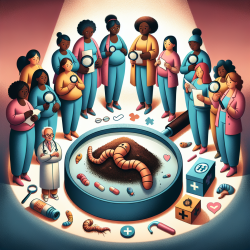Introduction
In the realm of public health, addressing the needs of vulnerable populations is paramount. One such group that has been historically overlooked is women of reproductive age (WRA), who are at significant risk for soil-transmitted helminth (STH) infections. The research article "The right to deworming: The case for girls and women of reproductive age" sheds light on the critical need for deworming interventions among this demographic. This blog post aims to provide practitioners with insights on how to implement the outcomes of this research and encourages further investigation into this pressing issue.
The Burden of STH Infections on WRA
Globally, STH infections, primarily caused by hookworm and Trichuris trichiura, contribute significantly to anemia among WRA. This group, alongside preschool and school-age children, is one of the most vulnerable to STH morbidity. Despite the increasing coverage of deworming programs for children, WRA remain underserved. In 2015, over 688 million WRA in STH-endemic countries required deworming treatment, yet coverage remains inadequate.
Challenges and Opportunities
Several challenges impede the effective implementation of deworming programs for WRA:
- Lack of drug donation programs specifically for WRA.
- Concerns about the safety of deworming during pregnancy, particularly in the first trimester.
- Insufficient data on treatment coverage and outcomes for WRA.
However, these challenges present opportunities for innovative solutions. Community-based strategies tailored to different subgroups of WRA, such as adolescent girls, pregnant women, lactating women, and nonpregnant nonlactating women, are essential. Existing platforms like schools, antenatal care clinics, and well-baby clinics can be leveraged to reach these women effectively.
Implementing Research Outcomes
Practitioners can play a pivotal role in expanding deworming initiatives for WRA by:
- Integrating deworming with existing health programs, such as iron supplementation for pregnant women.
- Utilizing social technologies to raise awareness and educate women and health personnel about the benefits and safety of deworming.
- Advocating for policy changes that support routine deworming for WRA.
Moreover, practitioners should engage in operational research to monitor and evaluate the impact of deworming programs on maternal and infant health outcomes. This data-driven approach will ensure that interventions are effective and cost-efficient.
Encouraging Further Research
While significant strides have been made, there is a need for continued research to address outstanding questions, such as:
- The long-term impact of deworming on maternal and infant health.
- The cost-effectiveness of various deworming platforms for WRA.
- Strategies to overcome barriers to treatment uptake, especially during pregnancy.
By fostering a culture of inquiry and collaboration, practitioners can contribute to the development of comprehensive deworming strategies that improve health outcomes for WRA globally.
Conclusion
The research presented in "The right to deworming: The case for girls and women of reproductive age" underscores the urgent need to expand deworming initiatives for WRA. By implementing the research outcomes and pursuing further investigation, practitioners can ensure that every woman at risk of STH can benefit from effective treatment. This collective action will not only improve individual health outcomes but also promote broader public health goals.
To read the original research paper, please follow this link: The right to deworming: The case for girls and women of reproductive age.










